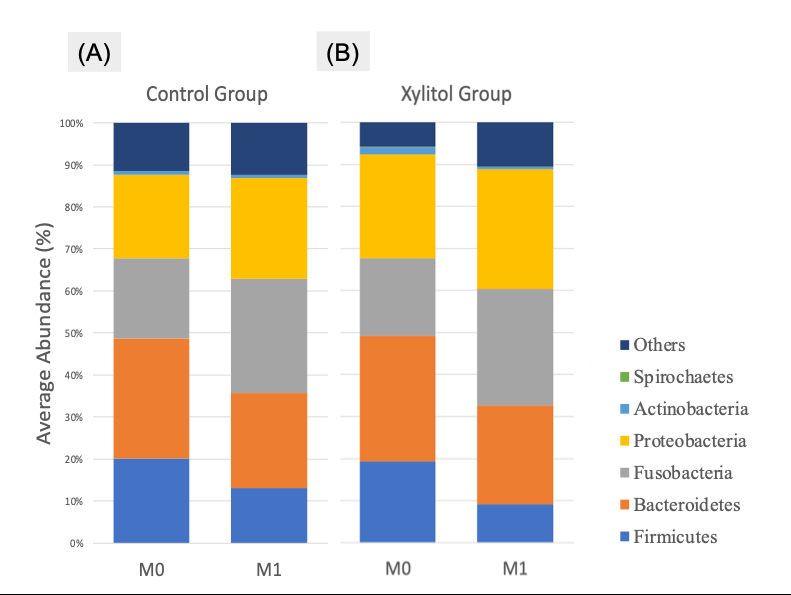IADR Abstract Archives
Xylitol gum Helps Reduce Cariogenic and Periodontopathic Bacteria on Dental Plaque Microbiota
Objectives: Xylitol could influence cariogenic and periodontopathic bacteria growth in the oral cavity, which later could influence oral microbiota. A randomized controlled trial (RCT) was designed to investigate the microbiota changes, using PacBio platform third-generation sequencing among young adults after chewing xylitol gum and without chewing for two weeks.
Methods: The effect of xylitol chewing gum on dental plaque accumulation and microbiota composition using the PacBio full-length sequencing platform was investigated in twenty-four young adults (N = 24). The participants were randomly assigned to xylitol chewing gum, and control with no-chewing groups. Participants in the chewing gum groups chewed ten pieces of gums (6.2 g xylitol/day). Dental plaque from all teeth was collected for weighing, measuring pH value, and analyzing microbial communities at the beginning (baseline, M0) and the end of the two weeks (effect, M1) of this study.
Results: Results suggested that a 20% reduction in dental plaque accumulation (p < 0.05) among participants chewing xylitol gum for two weeks, and the relative abundance of Firmicutes (a kind of pathogenic bacteria associated with caries) decreased by 10.26% (p < 0.05), and that of Bacteroidetes and Actinobacteria (two kinds of pathogenic bacteria associated with periodontitis) decreased by 6.32% (p < 0.001) and 1.66% (p < 0.05), respectively. Moreover, the relative abundance of Fusobacteria was increased by 9.24% (p < 0.001), which has been proven to have a higher proportion in dental plaque of healthy adults. However, the dental plaque pH value stayed in a healthy range for two groups.
Conclusions: In conclusion, chewing xylitol gum would benefit both cariogenic and periodontal bacteria reduction in the oral cavity.
Methods: The effect of xylitol chewing gum on dental plaque accumulation and microbiota composition using the PacBio full-length sequencing platform was investigated in twenty-four young adults (N = 24). The participants were randomly assigned to xylitol chewing gum, and control with no-chewing groups. Participants in the chewing gum groups chewed ten pieces of gums (6.2 g xylitol/day). Dental plaque from all teeth was collected for weighing, measuring pH value, and analyzing microbial communities at the beginning (baseline, M0) and the end of the two weeks (effect, M1) of this study.
Results: Results suggested that a 20% reduction in dental plaque accumulation (p < 0.05) among participants chewing xylitol gum for two weeks, and the relative abundance of Firmicutes (a kind of pathogenic bacteria associated with caries) decreased by 10.26% (p < 0.05), and that of Bacteroidetes and Actinobacteria (two kinds of pathogenic bacteria associated with periodontitis) decreased by 6.32% (p < 0.001) and 1.66% (p < 0.05), respectively. Moreover, the relative abundance of Fusobacteria was increased by 9.24% (p < 0.001), which has been proven to have a higher proportion in dental plaque of healthy adults. However, the dental plaque pH value stayed in a healthy range for two groups.
Conclusions: In conclusion, chewing xylitol gum would benefit both cariogenic and periodontal bacteria reduction in the oral cavity.

